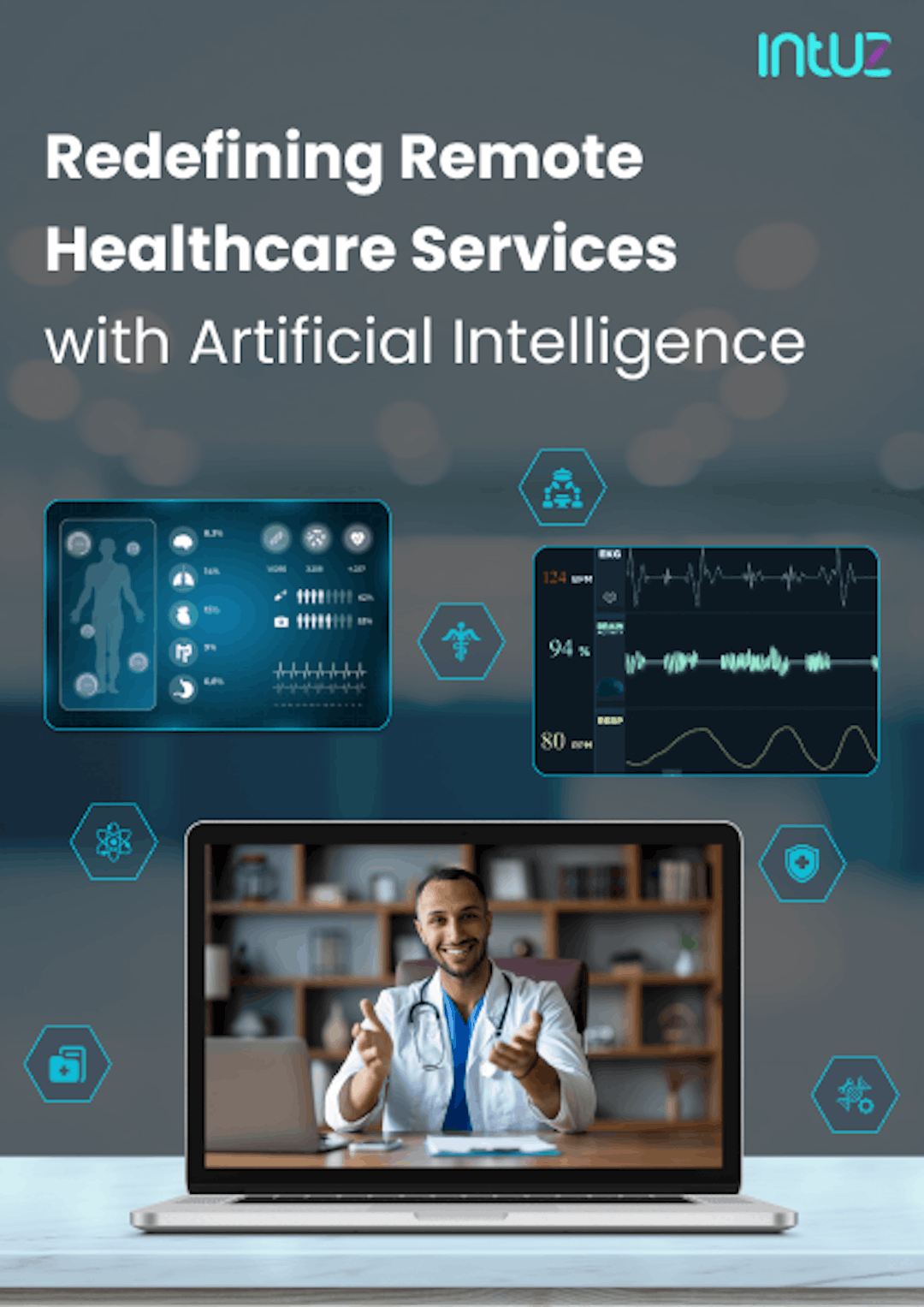Table of Content
How AI Predictive Analytics is Revolutionizing Healthcare?
When it comes to our health, especially in matters of life and death, making accurate predictions and data-driven decisions is vital. Gone are the days when healthcare relied solely on generalized, one-size-fits-all approaches.
The COVID-19 pandemic and the rise of Artificial Intelligence (AI), especially Generative AI, have demonstrated the critical importance of adaptability and precision in medical responses.
Today, healthcare service providers and patients need support at every stage of the care continuum. Partnering with an AI development company for predictive analytics can enable more proactive and personalized medical care.
It leverages huge amounts of healthcare data, including the patient’s medical records, treatment outcomes, genetic information, and lifestyle choices, to train algorithms that:
- Forecast the likelihood of disease recurrence
- Anticipate future industry requirements
- Optimize custom treatment protocols
With the global healthcare predictive analytics market expected to reach $34.1 billion by 2030, growing at a CAGR of 20.4% from 2024 to 2030, it’s imperative to understand how this technology can make a difference.
Check out eight real-world use cases of AI predictive analytics in the healthcare industry and how healthcare AI solutions can be beneficial for healthcare service providers.
What is AI Predictive Analytics in Healthcare?
AI predictive analytics is a branch of healthcare that involves the use of AI to analyze large patient datasets. This information can come from medical histories, lab results, and imaging. The AI is used to predict what might happen concerning the data input.
Years of training data were dumped into algorithms. Now, the AI predictive models that have been developed can predict disease risk, personalise treatment plans, and even anticipate the deterioration of a patient's health.
The use of predictive analytics in hospitals has reduced the rate of readmissions by 10% to 20% as indicated in the most recent studies.
Predictive AI in healthcare has become a staple template for holistic stability and patient care. If implemented accurately, the proactive engagement of this technology could streamline the entire machinery behind healthcare.
From proper implementation of this technology, institutions can benefit in resource allocation, decreased costs, improved care for patients, and optimised operations.
Transforming Healthcare with Predictive AI Technology
AI systems analyze patient records to identify subtle patterns, facilitating early diagnosis and treatment of diseases like cancer and Alzheimer’s, significantly improving patient outcomes.
AI leverages individual genetic, environmental, and lifestyle data to create personalized treatment plans, optimizing medication effectiveness and reducing unnecessary interventions.
AI models, like the one from Arizona State University, predict adverse drug reactions by analyzing molecular interactions, improving patient safety and treatment efficacy.
AI accelerates drug discovery by scanning chemical libraries and predicting drug interactions with biological systems, shortening the time to market and finding new uses for existing drugs.
AI-driven epidemiology predicts disease outbreaks by analyzing vast datasets from various sources, enabling proactive measures and resource allocation to contain and control the spread of diseases.
Wearable devices and predictive algorithms monitor vital signs in real-time, alerting healthcare service providers to anomalies and enabling timely interventions, thus improving patient health management.
AI predicts patient admission peaks and resource needs, improving appointment scheduling, inventory management, and administrative efficiency. This leads to cost savings and better patient care.
AI identifies patients at risk and suggests personalized follow-up care and discharge plans, reducing readmissions and improving patient outcomes.
Eight real-world use cases of AI predictive analytics in healthcare
The most prominent and real-world use cases of AI predictive analytics in healthcare are diagnosing disease, personalized medicine, predicting drug side effects and disease outbreaks, faster drug discovery and repurposing, optimizing healthcare resources, and reducing readmissions. Explore each of them in detail with examples.
1. Diagnosing diseases using AI-driven insights
Historically, diagnosis was regarded as the primary guide to treatment and prognosis, which is what’s likely to happen in the future. Although still considered a core part of clinical practice, it now must contend with the increasing complexity and multi-morbidity in patients.
Modern diagnosis demands a more nuanced understanding of diseases, which is where predictive models and AI enter the picture.
These technologies help identify subtle patterns in the Electronic Health Records of the patient that may escape human observers and detect medical conditions in their nascent stages when most treatable.
For example, in cancer care, AI systems integrate information across domains, such as pathology (bloodwork), radiology (tumor imaging), and genomics (genetic data), to predict malignancy, growth rate, potential complications, and possible spread of cancer.
Moreover, AI-based image reconstruction notably increases productivity in Magnetic Resonance (MR) departments and reduces the cost per exam while supporting diagnostic confidence with high-resolution medical images.
This data, in turn, assists multidisciplinary tumor boards in curating a timely course of action to improve the patient’s survival rate.
In another scenario, AI’s diagnostic prowess extends to neurological conditions like Alzheimer’s. By analyzing patterns in brain imaging and cognitive performance data, AI can detect early signs of the disease, facilitating earlier intervention strategies to slow disease progression.
2. Personalizing medicine and treatment plans
The human body is complex and reacts differently to different medicines. This is even more important in today’s post-COVID-19 climate. We understand that genetics influence how individuals metabolize and respond to medications.
Precision health takes into account variations in people’s genes, environments, and lifestyles, formulating treatment and prevention strategies that cater to their unique backgrounds and conditions.
Technological advancements, such as generative AI, have powered the shift towards personalized medicine. It analyzes individual patient profiles, comprising medical history, genetic data, and lifestyle factors, to pinpoint therapeutic approaches.
For example, in chronic disease management, such as in the case of diabetes, AI technology can monitor a patient’s glucose levels in real-time and recommend custom diet and medication plans to regulate blood sugar.
The targeted treatment optimizes the overall efficiency of healthcare systems by reducing unnecessary treatments and hospitalizations for chronic conditions.
3. Predicting drug side effects for safer treatments
Arizona State University (ASU) has developed a Machine Learning (ML) model that predicts how a patient’s immune system responds to foreign pathogens upon consuming a new drug. The Machine Learning algorithm focuses on the role of MHC-1 proteins, critical players in the body’s ability to recognize foreign cells.
The study is commendable because by understanding individualized molecular interactions, healthcare service providers can infer patterns about drug interaction side effects and predict previously unseen consequences from taking two drugs together.
For instance, a patient with hypertension is experiencing side effects from their current medication, hydrochlorothiazide, including severe dehydration and occasional hypokalemia.
The healthcare provider can input their medical history, current medications, and recent lab results into an AI-powered clinical decision support system (CDSS). The system can also access the patient’s genetic information, influencing drug metabolism.
Using pharmacokinetic and pharmacodynamic modeling, AI can simulate how different drugs and dosages might interact with the patient’s specific biological pathways.
Based on research, healthcare service providers can switch the patient to a different class of antihypertensive, such as an angiotensin II receptor blocker (ARB). This drug is generally well-tolerated and doesn’t have the same side effects as hydrochlorothiazide.
Improving treatment safety from the get-go can lead to fewer emergency room visits and reduce the financial burden on healthcare systems. They’re also better equipped to comply with stringent medical safety regulations and offer superior quality of care.
4. Accelerating drug discovery and repurposing
Remember how urgent it was to find a vaccine for COVID-19 in 2020? Pharmaceutical companies took almost a year to develop one successfully; however, drug discovery is generally time-consuming.
The conceptualization-to-market delivery time for a drug takes anywhere between 12 to 18 years. Drug discovery is also a complex process and involves steps like target identification and validation, lead optimization, and hit identification, costing $2.6 billion on average.
The good news is that generative models can scan vast chemical libraries and simulate countless scenarios using advanced algorithms to predict how new drugs might interact with biological systems.
For example, drug A might interact with specific cellular receptors to inhibit the progression of diseases such as cardiovascular disorders. The AI models can analyze the drug’s structure and compare it to known effective compounds, predicting efficacy and potential side effects.
This speeds up drug discovery by narrowing the candidate pool to the most promising compounds before physical trials begin.
In addition, Generative AI helps to find new therapeutic uses for existing drugs. For example, a medication initially developed for arthritis could be studied by AI to determine its effects on immune system pathways.
This could reveal that the drug has potential benefits for treating autoimmune skin conditions, resulting in faster clinical application and better patient engagement with minimal human error.
5. Predicting and preventing outbreaks with AI-driven epidemiology
In February 2024, the University of Virginia built an online Big Data dashboard to track the burden of enteric infectious diseases in low—and middle-income countries.
The dashboard pulls data from various sources and maps transmission hotspots to predict outbreaks of diarrheal diseases. The research team indicated that diarrhea is a major cause of childhood illness and mortality, and this problem will only worsen due to climate change.
Predictive analytics tools allow healthcare service providers to assess better and manage the risks associated with diseases in vulnerable populations.
AI algorithms stemming from Natural Language Processing (NLP) can integrate and process data from disease prevalence statistics, travel and migration patterns, weather conditions, and even trends in social media and internet search behaviors to identify potential outbreak patterns before they become public health crises.
For example, this technology can analyze historical data on dengue occurrences, recent unusually high rainfall patterns, increased global travel to the region, and a spike in local online searches for fever and rash symptoms.
This capability allows for immediate response and strategic resource allocation, ensuring that medical supplies, healthcare personnel, and preventive measures are directed where they’re most needed to effectively contain and control the spread of disease.
Plus, timely interventions can improve patient health outcomes and reinforce the public’s trust in the healthcare sector.
6. Monitoring patient health remotely
Wearable devices continuously gather vital signs, such as heart rate, blood pressure, sleep patterns, and glucose levels.
AI algorithms can analyze this data in real-time to identify deviations from normal patterns, which indicate emerging health issues, such as respiratory disorders, cardiac events, or uncontrolled blood sugar levels.
When such anomalies are detected, the wearable can automatically alert medical professionals or healthcare service providers so that they can intervene quickly, possibly even before the patient is aware of the problem.
For example, atrial fibrillation affects millions of people each year. However, the condition often goes unrecognized and untreated. Wearables can monitor heart rhythm disturbances based on remote electrocardiogram (ECG) recordings and enable fast and efficient cardiac care.
Moreover, AI technology allows patients to manage their health. With access to real-time insights, they can make informed decisions about their lifestyle and treatment options. This could be as simple as getting notified to maintain appropriate volume levels while wearing AirPods.
In more severe cases, AI systems can guide patients on when to take medications, suggest modifications in exercise, and provide reminders for follow-up appointments or blood tests, thereby maintaining optimal health and reducing hospital visits.
7. Optimizing resources to save healthcare costs
Through predictive modeling, AI systems identify potential bottlenecks and inefficiencies that disrupt the smooth functioning of healthcare services.
For instance, the technology can predict peak times for patient admissions and recommend ideal appointment scheduling slots to ensure that staff and resources (e.g., procedural trays, MRI scanning machines, X-ray equipment, etc.) are adequately available when required without being over-extended.
This predictive capability also ensures that healthcare facilities maintain the right amount of inventory—medicines, syringes, swabs, surgical gowns, masks, and more—avoiding shortages and costly overstocks.
Plus, by automating routine processes, such as patient registration, billing, and claims processing, AI deep learning models minimize the workload on administrative staff. They empower them to handle financial transactions and critical patient data better.
When healthcare facilities operate in top condition, they can care for more patients in a given period by using the appropriate resources, which contributes to the overall sustainability and quality of healthcare institutions.
8. Reducing readmissions and improving patient satisfaction
Hospital readmissions are considered a major focus of care quality as they put an unnecessary physical, social, and emotional burden on patients. On the other hand, healthcare service providers incur billions of dollars annually because of readmissions.
Research conducted by the NIH found that 15.3% of 491 patients were readmitted within a month of their discharge. Their length of stay for index and readmission was between four and seven days. The most common cause of readmission was persistence of symptoms (43%).
Advanced analytics in healthcare allow facilities to provide better care. The technology can help identify at-risk patients and assist in implementing specialized follow-ups so that they are not discharged until they’re completely cured.
This predictive capability is achieved by analyzing a wide range of data, including previous hospitalization records, detailed patient histories, and treatment outcomes.
Besides follow-up appointments, customized discharge plans might include rehabilitation programs and targeted education about managing symptoms at home.
AI systems can also suggest adjustments in post-discharge care, such as home health services or remote monitoring, to ensure that patients receive appropriate support. This can significantly reduce the likelihood of complications leading to readmissions.
How Intuz can help integrating AI predictive analytics into your healthcare system
Intuz brings the power of AI predictive analytics to healthcare systems, driving smarter decision-making and improved patient care. Our solutions incorporate machine learning algorithms and real-time data processing that enable predicting disease risk, optimising treatment plans, and reducing hospital readmission.
That model will analyse historical and real-time data, a process which reveals hidden patterns that produce a holistic picture of patient prognosis and therapeutic possibilities.
At Intuz, our proficiency in customizing AI models and application development to meet specific medical needs can help enable early diagnosis, personalised medicine recommendations, resource allocation, and boosting operational efficiency. Our user-friendly and intuitive development solutions can help you gain action-oriented insights. With secure cloud integrations in our personalised process, Intuz assures compliance with healthcare standards.
Partnering with Intuz means accessing the latest in advanced AI technology geared towards transforming healthcare delivery. We have the capabilities to ensure your healthcare institution will embody a predictive analytics program that will drive proactive patient care and streamline overall operations.
Generative AI in Pharma - Exploring the Innovative Use Cases
Also ReadIn conclusion
There’s no doubt that AI-powered predictive analytics will transform the healthcare sector significantly by setting up mechanisms for early disease detection, personalized treatment plans, and optimized healthcare organizations’ resource usage and expense.
The technology demonstrates the potential to future-proof our health systems and provide better support to the people. If you’re a healthcare service provider, predictive analysis can help you run a well-oiled care machine that puts patients at the forefront of everything you do.
To understand how to leverage AI-powered predictive analytics in your healthcare organization, please book a 45-minute call with Intuz’s AI experts today. Also, receive a free roadmap to get started with technology adoption.







